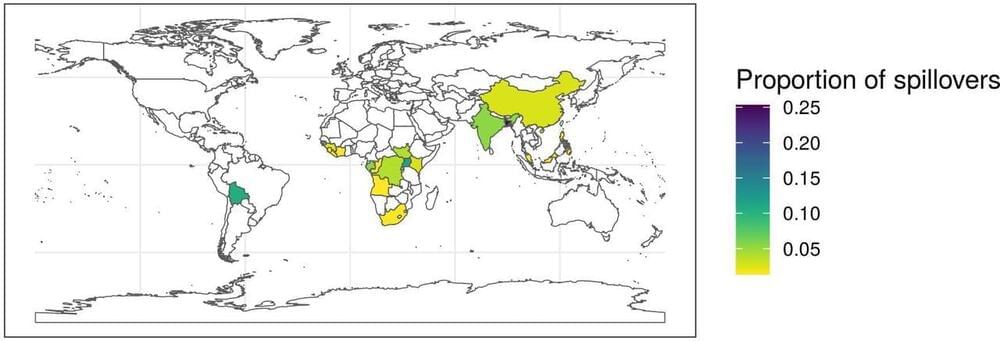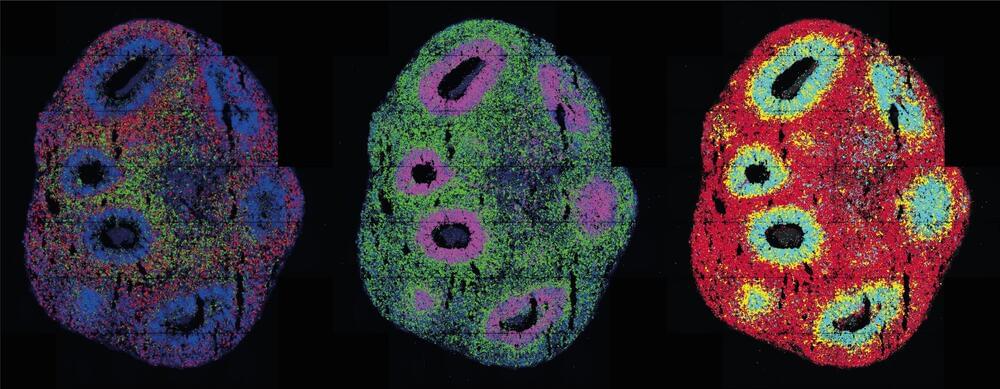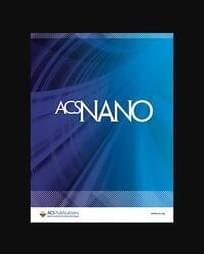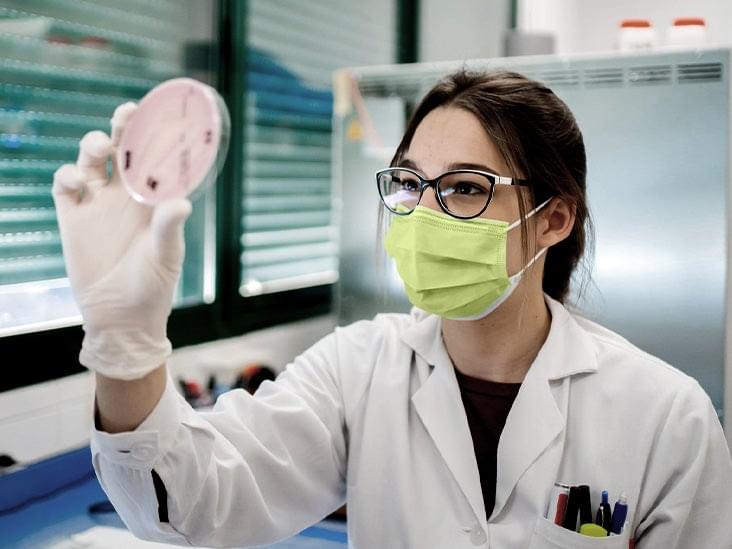The breakthrough opens the way for designing and building more complex structures.



The COVID-19 pandemic has focused attention on patterns of infectious disease spillover. Climate and land-use changes are predicted to increase the frequency of zoonotic spillover events, which have been the cause of most modern epidemics. Characterising historical trends in zoonotic spillover can provide insights into the expected frequency and severity of future epidemics, but historical epidemiological data remains largely fragmented and difficult to analyse. We utilised our extensive epidemiological database to analyse a specific subset of high-consequence zoonotic spillover events for trends in the annual frequency and severity of outbreaks. Our analysis, which excludes the ongoing SARS-CoV-2 pandemic, shows that the number of spillover events and reported deaths have been increasing by 4.98% (confidence interval [CI]95% [3.22%; 6.76%]) and 8.7% (CI 95% [4.06%; 13.62%]) annually, respectively. This trend can be altered by concerted global efforts to improve our capacity to prevent and contain outbreaks. Such efforts are needed to address this large and growing risk to global health.

Harnessing and controlling light plays a pivotal role in technological advancement, impacting energy harvesting, computation, communications, and biomedical sensing. Nevertheless, in real-world scenarios, the intricate behavior of light presents challenges for efficient control.
Physicist Andrea Alù draws a parallel between the behavior of light in chaotic systems and a game of billiards, where slight variations in the cue ball’s launch result in different ball trajectories on the table.
“In billiards, tiny variations in the way you launch the cue ball will lead to different patterns of the balls bouncing around the table,” said Alù, Einstein Professor of Physics at the CUNY Graduate Center, founding director of the Photonics Initiative at the CUNY Advanced Science Research Center and distinguished professor at CUNY. “Light rays operate in a similar way in a chaotic cavity. It becomes difficult to model to predict what will happen because you could run an experiment many times with similar settings, and you’ll get a different response every time.”

Researchers at the Barrow Neurological Institute have conducted a study revealing that residing in areas with average air pollution levels is associated with a 56% increased risk of Parkinson’s disease when compared to those living in regions with the lowest level of air pollution.
The study, which was recently published in Neurology – the medical journal of the American Academy of Neurology – was conducted to identify national, geographic patterns of Parkinson’s disease and test for nationwide and region-specific associations with fine particulate matter.
“Previous studies have shown fine particulate matter to cause inflammation in the brain, a known mechanism by which Parkinson’s disease could develop,” says Brittany Krzyzanowski, PhD, a researcher at Barrow Neurological Institute, who led the study. “Using state-of-the-art geospatial analytical techniques, we were, for the first time, able to confirm a strong nationwide association between incident Parkinson’s disease and fine particulate matter in the U.S.”
CNBC’s Andrea Day joins Shep Smith to report on ‘robot nurses’ meant to give a hand to live nurses, who suffered under very difficult conditions during the pandemic. For access to live and exclusive video from CNBC subscribe to CNBC PRO: https://cnb.cx/2NGeIvi.
» Subscribe to CNBC TV: https://cnb.cx/SubscribeCNBCtelevision.
» Subscribe to CNBC: https://cnb.cx/SubscribeCNBC
Turn to CNBC TV for the latest stock market news and analysis. From market futures to live price updates CNBC is the leader in business news worldwide.
The News with Shepard Smith is CNBC’s daily news podcast providing deep, non-partisan coverage and perspective on the day’s most important stories. Available to listen by 8:30pm ET / 5:30pm PT daily beginning September 30: https://www.cnbc.com/2020/09/29/the-news-with-shepard-smith-…%7Cpodcast.
Connect with CNBC News Online.
Get the latest news: http://www.cnbc.com/
Follow CNBC on LinkedIn: https://cnb.cx/LinkedInCNBC
Follow CNBC News on Facebook: https://cnb.cx/LikeCNBC
Follow CNBC News on Twitter: https://cnb.cx/FollowCNBC
Follow CNBC News on Instagram: https://cnb.cx/InstagramCNBC

In the future, it could facilitate an even greater fusion between retinal implants and the human body.
A multinational group lead by Francesca Santoro, a researcher at Jülich, has created an intelligent biochip that effectively mimics the human retina, opening up new possibilities in bioelectronics.
The retina is a layer of neural tissue located at the back of the eye that plays a crucial role in the visual process. This key part of the eye is in charge of translating light into electrical signals that are transmitted to the brain, enabling us to see and understand images. It is this process that the new biochip recreates.

They look like storm clouds that could fit on the head of a pin: Organoids are three-dimensional cell cultures that play a key role in medical and clinical research. This is thanks to their ability to replicate tissue structures and organ functions in the petri dish. Scientists can use organoids to understand how diseases occur, how organs develop, and how drugs work.
Single-cell technologies allow researchers to drill down to the molecular level of the cells. With spatial transcriptomics, they can observe which genes in the organoids are active and where over time.
The miniature organs are usually derived from stem cells. These are cells that haven’t differentiated at all, or only minimally. They can become any kind of cell, such as heart or kidney cells, muscle cells, or neurons. To make stem cells differentiate, scientists “feed” them with growth factors and embed them in a nutrient solution.
Join us on Patreon! https://www.patreon.com/MichaelLustgartenPhD
Discount Links:
NAD+ Quantification: https://www.jinfiniti.com/intracellular-nad-test/
Use Code: ConquerAging At Checkout.
Epigenetic, Telomere Testing: https://trudiagnostic.com/?irclickid=U-s3Ii2r7xyIU-LSYLyQdQ6…M0&irgwc=1
Use Code: CONQUERAGING
At-Home Metabolomics: https://www.iollo.com?ref=michael-lustgarten.
Use Code: CONQUERAGING At Checkout.
Oral Microbiome: https://www.bristlehealth.com/?ref=michaellustgarten.
Enter Code: ConquerAging.
At-Home Blood Testing (SiPhox Health): https://getquantify.io/mlustgarten.

Engineered vesicular stomatitis virus (VSV) pseudotyping offers an essential method for exploring virus–cell interactions, particularly for viruses that require high biosafety levels. Although this approach has been employed effectively, the current methodologies for virus visualization and labeling can interfere with infectivity and lead to misinterpretation of results. In this study, we introduce an innovative approach combining genetic code expansion (GCE) and click chemistry with pseudotyped VSV to produce highly fluorescent and infectious pseudoviruses (clickVSVs). These clickVSVs enable robust and precise virus–cell interaction studies without compromising the biological function of the viral surface proteins. We evaluated this approach by generating VSVs bearing a unique chemical handle for click labeling and assessing the infectivity in relevant cell lines.

These risks may be amplified with longer-lasting treatments, as Dr. Shafipour cautioned:
“Higher levels of GLP-1 are associated with more gastrointestinal side effects, including nausea, acid reflux, constipation, and bloating, which in some individuals, could be a cause for discontinuation of the drug.”
However, she added: “If this is not a side effect due to this novel technology, this could be a great advantage over the current GLP-1 receptor agonists.”